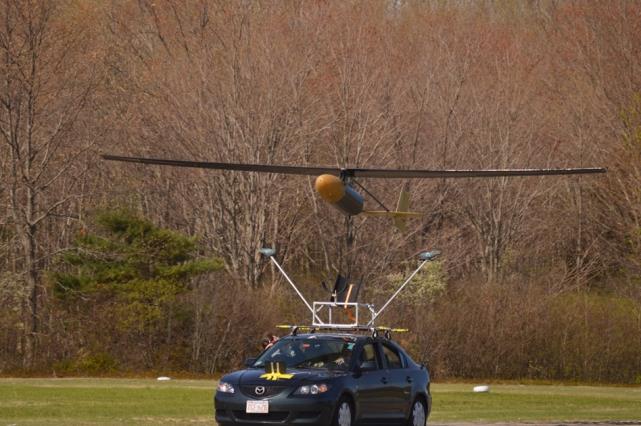The UAV, which has a 24-foot wingspan, can carry 5 to 10kg of communications equipment while flying at an altitude of 15,000 feet. Weighing in at just under 68kg, the vehicle is powered by a 5-horsepower petrol engine and can keep itself aloft for more than five days — longer than any petrol-powered autonomous aircraft has remained in flight, the researchers say.
In 2016, the US Air Force approached MIT with an idea for designing a long-duration UAV powered by solar energy. The thought at the time was that an aircraft, fuelled by the sun, could potentially remain in flight indefinitely. Others, including Google and Facebook, have experimented with this concept, designing solar-powered, high-altitude aircraft to deliver continuous internet access to rural and remote parts of the world.
But when the team looked into the idea and analysed the problem from multiple engineering angles, they found that solar power — at least for long-duration emergency response — was not the way to go.
“[A solar vehicle] would work fine in the summer season, but in winter, particularly if you’re far from the equator, nights are longer, and there’s not as much sunlight during the day. So, you have to carry more batteries, which adds weight and makes the plane bigger,” said R. John Hansman, Professor of Aeronautics and Astronautics at MIT’s Beaver Works project, a student research collaboration between MIT and the MIT Lincoln Laboratory. “For the mission of disaster relief, this could only respond to disasters that occur in summer, at low latitude. That just doesn’t work.”
The researchers came to their conclusions after modelling the problem using GPkit, a software tool developed by Prof Warren Hoburg, also of the Beaver Works project, that allows engineers to determine the optimal design decisions or dimensions for a vehicle, given certain constraints or mission requirements.
Unlike traditional aircraft design tools, which take into account only several main constraints, Prof Hoburg’s method allowed the team to consider around 200 constraints and physical models simultaneously, and to fit them all together to create an optimal aircraft design.
In the autumn of 2016, the team built a prototype UAV using carbon fibre for its wings and fuselage and Kevlar for the tail and nosecone, which houses the payload. The UAV is designed to be easily taken apart and stored in a FedEx box, to be shipped to any disaster region and quickly reassembled.
 A launch system was developed in the spring of 2017, comprising a simple metal frame to fit on a typical car roof rack. The UAV sits atop the frame as a driver accelerates up to the UAV’s optimal take-off speed. The UAV would then be angled upwards, a fastener would then be released, allowing the UAV to lift off.
A launch system was developed in the spring of 2017, comprising a simple metal frame to fit on a typical car roof rack. The UAV sits atop the frame as a driver accelerates up to the UAV’s optimal take-off speed. The UAV would then be angled upwards, a fastener would then be released, allowing the UAV to lift off.
The team has conducted initial tests, but Prof Hoburg says there are special considerations that must be made to test the vehicle over multiple days, such as having enough people to monitor the aircraft over a long period of time. However, he added: “We’re pretty confident that we have the right fuel burn rate and right engine that we could fly it for five days.”
Prof Hansman pointed out that there are uses for this type of drone in addition to disaster relief, such as environmental monitoring such as keeping watch on wildfires or the outflow of rivers.





